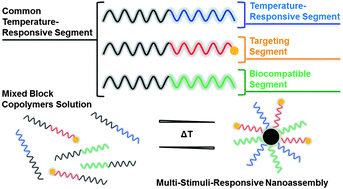
Core–shell nanoassemblies made from amphiphilic block copolymers have shown potential for use as a drug delivery system. A great deal of work has been focused on the design of sophisticated stimuli-sensitive nanoassemblies in order to take advantage of the environment changes that occur in nature.
In this view, Aoyagi and co-workers reported an original method to prepare nanoassemblies with targetable and tunable shell functions by simply mixing three different block copolymers with a common temperature-responsive segment. The building blocks, acrylamide-type P(NIPAAm-co–N-(hydroxymethyl)acrylamide (HMAAm))-b-P(NIPAAm-co-BMAAm), poly(ethylene oxide) (PEO)-b-P(NIPAAm-co-BMAAm), and methacrylate-type poly(2-lactobionamidoethyl methacrylate) (PLAMA)-b-P(NIPAAm-co-HMAAm)-b-P(NIPAAm-co-BMAAm), were successfully polymerized by reversible addition–fragmentation chain transfer (RAFT) polymerization. Regardless of the block copolymer types, they formed a stable core–shell assembly with the collapsed common segments by simple mixing in aqueous solutions. The flexibility of designing block copolymers with a favorable functional group and the simple mixing of the selected block copolymers make the present concept considerably advantageous over self-assembly of the one block copolymer system. This study could open up new possibilities toward effective and facile encapsulation, targeting, and triggered release of drugs.
A ‘smart’ approach towards the formation of multifunctional nano-assemblies by simple mixing of block copolymers having a common temperature sensitive by Yohei Kotsuchibashi, Mitsuhiro Ebara, Naokazu Idota, Ravin Narain and Takao Aoyagi Polym. Chem., 2012, 3, 1150-1157.
To keep up-to-date with all the latest research, sign up for the journal’s e-alerts or RSS feeds or follow Polymer Chemistry on Twitter or Facebook










